
by Contributed | Dec 7, 2021 | Dynamics 365, Microsoft 365, Technology
This article is contributed. See the original author and article here.
In recent years, retailers, consumer packaged goods (CPG) companies, and manufacturers have incorporated direct-to-consumer (D2C) business models into their go-to-market strategies to give end customers the options to order from anywhere and ship to everywhere. As the use of these online sales channels continues to expand, so too does the number of third-party fulfillment partners and options to evaluate and incorporate into their supply chain and commerce systems. Organizations with business-to-business (B2B), business-to-business-to-consumer (B2B2C), and D2C business models, require technology solutions that give them the ability to manage an increasingly complex order lifecycle from order source through orchestration to intelligent fulfillment and delivery.
According to Gartner, “83 percent of chief information officers (CIOs) stated they were expanding digital channels in 2021, while 79 percent plan to increase the use of self-service by customers and citizens.”1 With Microsoft Dynamics 365 Intelligent Order Management, companies can stay on top of their game through digital channels, as Dynamics 365 Intelligent Order Management enhances their digital order and delivery channels. It provides real-time visibility into each order from order intake to delivery, and customizable dashboards to help track and improve operational decision-making across every touchpoint of the order life cycle.
Overcome fulfillment complexity
Managing the entire order lifecycle is about placing your organization in a position to deliver on your order promise with every customer order. But there are other undeniable benefits, such as reducing logistics costs by overcoming fulfillment complexities that await companies, who demonstrate the ability to do this well. Indeed, according to McKinsey & Company, “since e-commerce fulfillments are significantly more complex, contract logistics can charge around 50 percent more than for traditional store fulfillment. Therefore, those companies that overcome the complexities stand to gain the most.”2
Companies can overcome the complexities of e-commerce fulfillment by utilizing Dynamics 365 Intelligent Order Management rules-based fulfillment orchestration system that uses real-time inventory and AI to optimize order flows. This solution offers advanced analytical capabilities to measure fulfillment effectiveness and business users can use the insights to re-model the order fulfillment journey using drag and drop tools to ensure that their customer needs are met on time and at the lowest possible cost. In addition, Dynamics 365 Intelligent Order Management provides out-of-the-box pre-built connectors to e-commerce order sources such as BigCommerce, Magento, and Orderful; delivery partners such as Flexe, Krber, and ShipStation, and to tax and rebate management partners such as Avalara, Flintfox, and Vertex. All these capabilities provide organizations the agility needed to overcome supply chain constraints and deliver on their order promise.
Apply artificial intelligence
To profitably manage the entire order lifecycle, companies increasingly need to use AI and machine learning (ML) technologies in the supply chain. In fact, according to McKinsey & Company, “successfully implementing AI-enabled supply-chain management has enabled early adopters to improve logistics costs by 15 percent, inventory levels by 35 percent, and service levels by 65 percent, compared with slower-moving competitors.”3
With Dynamics 365 Intelligent Order Management, AI and ML are used to analyze data to find and predict patterns in order flows and fulfillment processes. The results help bring new levels of insights that would not otherwise be possible for human team members to spot alone. These results can then be paired with AI-based classification and anomaly detection models to proactively identify and address fulfillment constraints and to improve delivery times, while simultaneously reducing costs. The use of AI and ML enhances decision-making across all order orchestration flows by delivering the capability to sense and predict constraints, disruptions, and opportunities to improve order and fulfillment processes.
Enhance inventory visibility
Dynamics 365 Intelligent Order Management solution architecture was designed to support the requirements of complex order processing environments, where there are many systems and apps in the overall order-to-fulfillment process. By bringing visibility into many disparate data sources and applications; order flows, inventory, and supporting functions can be significantly improved. Dynamics 365 Intelligent Order Management ships out-of-the-box with an integrated real-time inventory visibility service that is highly scalable and extensible, and provides a single, global view of all inventory positions across all legal entities.
Dynamics 365 Intelligent Order Management not only provides organizations with a single, global view of all inventory positions, but its fulfillment orchestration engine also uses real-time inventory data to optimize fulfillment processes to ensure optimal stock levels are maintained across all stock locations. The result is that companies can increase online product availability, improve cash flow by right-sizing stock levels, and guarantee a delightful customer experience by delivering every order on time and in full.
What’s next?
We have seen that Dynamics 365 Intelligent Order Management is an ideal tool for managing the entire order lifecycle. By utilizing rules-based order orchestration to overcome fulfillment complexities, leveraging AI and ML to derive actionable insights, and optimizing stock levels by applying a real-time inventory visibility service, companies can deliver on their order promise and turn order management into a competitive advantage. Moreover, Dynamics 365 Intelligent Order Management seamlessly integrates with any enterprise resource planning (ERP), customer relationship management (CRM), e-commerce, Dynamics 365, and non-Dynamics 365 applications, allowing organizations to skip costly rip and replace implementations.
If you are ready to see how Microsoft Dynamics 365 Intelligent Order Management can help your organization to manage the entire order lifecycle, we invite you to get started today by contacting us or signing up for a free trial. Or, to learn more about how to meet your growing digital commerce needs and scale easily, while supporting the latest fulfillment methods, check the Dynamics 365 Intelligent Order Management resources on our website: Dynamics 365 Intelligent Order Management.
Sources:
- “Gartner, Add Digital Payments as Part of Communications Platform as a Service Offering, Lisa Unden-Farboud, Daniel O’Connell et al, 27 August, 2021.” GARTNER is the registered trademark and service mark of Gartner Inc., and/or its affiliates in the U.S. and internationally and has been used herein with permission. All rights reserved.
- McKinsey & Company, Unlocking the omnichannel opportunity in contract logistics, March 12, 2021, Tom Bartman, Scott McConnell, Florian Neuhaus, and Isabell Scheringer.
- McKinsey & Company, Succeeding in the AI supply-chain revolution, April 30, 2021, Knut Alicke, Valerio Dilda, Stephan Grner, Lapo Mori, Pierrick Rebuffel, Sebastian Reiter, and Robert Samek.
The post Why AI and real-time visibility are a game-changer for order lifecycle management appeared first on Microsoft Dynamics 365 Blog.
Brought to you by Dr. Ware, Microsoft Office 365 Silver Partner, Charleston SC.
by Scott Muniz | Dec 6, 2021 | Security, Technology
This article is contributed. See the original author and article here.
| acronis — agent |
Sensitive information could be logged. The following products are affected: Acronis Agent (Windows, Linux, macOS) before build 27147 |
2021-11-29 |
5 |
CVE-2021-34800
MISC |
| acronis — cyber_protect |
DLL hijacking could lead to local privilege escalation. The following products are affected: Acronis Cyber Protect 15 (Windows) before build 28035 |
2021-11-29 |
4.4 |
CVE-2021-44198
MISC |
| acronis — cyber_protect |
Cross-site scripting (XSS) was possible in notification pop-ups. The following products are affected: Acronis Cyber Protect 15 (Windows, Linux) before build 28035 |
2021-11-29 |
4.3 |
CVE-2021-44201
MISC |
| actions-semi — ats2819p_firmware |
The Bluetooth Classic implementation on Actions ATS2815 chipsets does not properly handle the reception of continuous unsolicited LMP responses, allowing attackers in radio range to trigger a denial of service and shutdown of a device by flooding the target device with LMP_features_res packets. |
2021-11-30 |
6.1 |
CVE-2021-31787
MISC
MISC
MISC |
| afreecatv — afreecatv |
The vulnerability function is enabled when the streamer service related to the AfreecaTV communicated through web socket using 21201 port. A stack-based buffer overflow leading to remote code execution was discovered in strcpy() operate by “FanTicket” field. It is because of stored data without validation of length. |
2021-11-26 |
6.5 |
CVE-2020-7881
MISC |
| aomedia — aomedia |
AOM v2.0.1 was discovered to contain a NULL pointer dereference via the component av1/av1_dx_iface.c. |
2021-12-02 |
4.3 |
CVE-2020-36130
MISC |
| aomedia — aomedia |
AOM v2.0.1 was discovered to contain a NULL pointer dereference via the component rate_hist.c. |
2021-12-02 |
4.3 |
CVE-2020-36135
MISC |
| aomedia — aomedia |
AOM v2.0.1 was discovered to contain a stack buffer overflow via the component src/aom_image.c. |
2021-12-02 |
6.8 |
CVE-2020-36129
MISC |
| aomedia — aomedia |
AOM v2.0.1 was discovered to contain a stack buffer overflow via the component stats/rate_hist.c. |
2021-12-02 |
6.8 |
CVE-2020-36131
MISC |
| aomedia — aomedia |
AOM v2.0.1 was discovered to contain a global buffer overflow via the component av1/encoder/partition_search.h. |
2021-12-02 |
6.8 |
CVE-2020-36133
MISC |
| aomedia — aomedia |
AOM v2.0.1 was discovered to contain a segmentation violation via the component aom_dsp/x86/obmc_sad_avx2.c. |
2021-12-02 |
4.3 |
CVE-2020-36134
MISC |
| backstage — backstage |
@backstage/plugin-scaffolder-backend is the backend for the default Backstage software templates. In affected versions a malicious actor with write access to a registered scaffolder template is able to manipulate the template in a way that writes files to arbitrary paths on the scaffolder-backend host instance. This vulnerability can in some situation also be exploited through user input when executing a template, meaning you do not need write access to the templates. This method will not allow the attacker to control the contents of the injected file however, unless the template is also crafted in a specific way that gives control of the file contents. This vulnerability is fixed in version `0.15.14` of the `@backstage/plugin-scaffolder-backend`. This attack is mitigated by restricting access and requiring reviews when registering or modifying scaffolder templates. |
2021-11-29 |
5.5 |
CVE-2021-43783
CONFIRM
MISC |
| bandisoft — ark_library |
ARK library allows attackers to execute remote code via the parameter(path value) of Ark_NormalizeAndDupPAthNameW function because of an integer overflow. |
2021-11-26 |
6.8 |
CVE-2021-26615
MISC |
| bannersky — bsk_pdf_manager |
The BSK PDF Manager WordPress plugin before 3.1.2 does not validate and escape the orderby and order parameters before using them in a SQL statement, leading to a SQL injection issue |
2021-11-29 |
6.5 |
CVE-2021-24860
MISC |
| bluez — bluez |
A heap-based buffer overflow was discovered in bluetoothd in BlueZ through 5.48. There isn’t any check on whether there is enough space in the destination buffer. The function simply appends all data passed to it. The values of all attributes that are requested are appended to the output buffer. There are no size checks whatsoever, resulting in a simple heap overflow if one can craft a request where the response is large enough to overflow the preallocated buffer. This issue exists in service_attr_req gets called by process_request (in sdpd-request.c), which also allocates the response buffer. |
2021-11-29 |
5.8 |
CVE-2019-8922
MISC
CONFIRM |
| bookstackapp — bookstack |
bookstack is vulnerable to Improper Access Control |
2021-11-30 |
4 |
CVE-2021-4026
CONFIRM
MISC |
| bookstackapp — bookstack |
bookstack is vulnerable to Cross-Site Request Forgery (CSRF) |
2021-12-02 |
4 |
CVE-2021-3944
MISC
CONFIRM |
| browser_and_operating_system_finder_project — browser_and_operating_system_finder |
Cross-site request forgery (CSRF) vulnerability in Browser and Operating System Finder versions prior to 1.2 allows a remote unauthenticated attacker to hijack the authentication of an administrator via unspecified vectors. |
2021-12-01 |
6.8 |
CVE-2021-20851
MISC
MISC |
| bulk_datetime_change_project — bulk_datetime_change |
The Bulk Datetime Change WordPress plugin before 1.12 does not enforce capability checks which allows users with Contributor roles to 1) list private post titles of other users and 2) change the posted date of other users’ posts. |
2021-11-29 |
5.5 |
CVE-2021-24842
MISC
CONFIRM |
| businessdnasolutions — topease |
Incorrect Access Control in Web Applications operating on Business-DNA Solutions GmbH’s TopEase® Platform Version <= 7.1.27 allows an authenticated remote attacker to view the Shape Editor and Settings, which are functionality for higher privileged users, via identifying said components in the front-end source code or other means. |
2021-11-30 |
4 |
CVE-2021-42116
CONFIRM |
| businessdnasolutions — topease |
Missing HTTPOnly flag in Web Applications operating on Business-DNA Solutions GmbH’s TopEase® Platform Version <= 7.1.27 allows an unauthenticated remote attacker to escalate privileges from unauthenticated to authenticated user via stealing and injecting the session- independent and static cookie UID. |
2021-11-30 |
6.4 |
CVE-2021-42115
CONFIRM |
| businessdnasolutions — topease |
Unrestricted File Upload in Web Applications operating on Business-DNA Solutions GmbH’s TopEase® Platform Version <= 7.1.27 in the File Upload Functions allows an authenticated remote attacker with Upload privileges to upload files with any file type, enabling client-side attacks. |
2021-11-30 |
6.5 |
CVE-2021-42123
CONFIRM |
| businessdnasolutions — topease |
Insufficient Input Validation in Web Applications operating on Business-DNA Solutions GmbH’s TopEase® Platform Version <= 7.1.27 on an object’s date attribute(s) allows an authenticated remote attacker with Object Modification privileges to insert an unexpected format into date fields, which leads to breaking the object page that the date field is present. |
2021-11-30 |
4 |
CVE-2021-42121
CONFIRM |
| businessdnasolutions — topease |
Insufficient Input Validation in Web Applications operating on Business-DNA Solutions GmbH’s TopEase® Platform Version <= 7.1.27 allows an authenticated remote attacker with Object Modification privileges to insert arbitrary HTML without code execution. |
2021-11-30 |
4 |
CVE-2021-42117
CONFIRM |
| businessdnasolutions — topease |
Insufficient Input Validation in Web Applications operating on Business-DNA Solutions GmbH’s TopEase® Platform Version <= 7.1.27 on all object attributes allows an authenticated remote attacker with Object Modification privileges to insert arbitrarily long strings, eventually leading to exhaustion of the underlying resource. |
2021-11-30 |
4 |
CVE-2021-42120
CONFIRM |
| businessdnasolutions — topease |
Insufficient Input Validation in Web Applications operating on Business-DNA Solutions GmbH’s TopEase® Platform Version <= 7.1.27 on an object’s attributes with numeric format allows an authenticated remote attacker with Object Modification privileges to insert an unexpected format, which makes the affected attribute non-editable. |
2021-11-30 |
4 |
CVE-2021-42122
CONFIRM |
| bytecodealliance — lucet |
Lucet is a native WebAssembly compiler and runtime. There is a bug in the main branch of `lucet-runtime` affecting all versions published to crates.io that allows a use-after-free in an Instance object that could result in memory corruption, data race, or other related issues. This bug was introduced early in the development of Lucet and is present in all releases. As a result of this bug, and dependent on the memory backing for the Instance objects, it is possible to trigger a use-after-free when the Instance is dropped. Users should upgrade to the main branch of the Lucet repository. Lucet no longer provides versioned releases on crates.io. There is no way to remediate this vulnerability without upgrading. |
2021-11-30 |
6.8 |
CVE-2021-43790
CONFIRM
MISC
MISC |
| cbads — clickbank_affiliate_ads |
The ClickBank Affiliate Ads WordPress plugin through 1.20 does not have CSRF check when saving its settings, allowing attacker to make logged in admin change them via a CSRF attack. Furthermore, due to the lack of escaping when they are outputting, it could also lead to Stored Cross-Site Scripting issues |
2021-12-02 |
6.8 |
CVE-2015-20105
MISC
MISC
MISC |
| chamilo — chamilo |
chamilo-lms v1.11.14 is affected by a Cross Site Scripting (XSS) vulnerability in /plugin/jcapture/applet.php if an attacker passes a message hex2bin in the cookie. |
2021-12-01 |
4.3 |
CVE-2021-43687
MISC
MISC
MISC |
| cloverdx — cloverdx |
CloverDX Server before 5.11.2 and and 5.12.x before 5.12.1 allows XXE during configuration import. |
2021-12-01 |
6.8 |
CVE-2021-42776
CONFIRM
MISC |
| codesys — git |
Affected versions of CODESYS Git in Versions prior to V1.1.0.0 lack certificate validation in HTTPS handshakes. CODESYS Git does not implement certificate validation by default, so it does not verify that the server provides a valid and trusted HTTPS certificate. Since the certificate of the server to which the connection is made is not properly verified, the server connection is vulnerable to a man-in-the-middle attack. |
2021-12-01 |
5.8 |
CVE-2021-34599
CONFIRM |
| concretecms — concrete_cms |
An issue was discovered in Concrete CMS before 8.5.7. The Dashboard allows a user’s password to be changed without a prompt for the current password. |
2021-11-30 |
6.5 |
CVE-2021-40101
CONFIRM
MISC |
| contact_form_with_captcha_project — contact_form_with_captcha |
The Contact Form With Captcha WordPress plugin is vulnerable to Cross-Site Request Forgery due to missing nonce validation in the ~/cfwc-form.php file during contact form submission, which made it possible for attackers to inject arbitrary web scripts in versions up to, and including 1.6.2. |
2021-11-29 |
6.8 |
CVE-2021-42358
MISC
MISC |
| craftercms — crafter_cms |
Unauthenticated remote attackers can read textual content via FreeMarker including files /scripts/*, /templates/* and some of the files in /.git/* (non-binary). |
2021-12-02 |
5 |
CVE-2021-23263
MISC |
| craftercms — crafter_cms |
Installations, where crafter-search is not protected, allow unauthenticated remote attackers to create, view, and delete search indexes. |
2021-12-02 |
6.4 |
CVE-2021-23264
MISC |
| craftercms — crafter_cms |
Authenticated administrators may modify the main YAML configuration file and load a Java class resulting in RCE. |
2021-12-02 |
6.5 |
CVE-2021-23262
MISC |
| craftercms — crafter_cms |
Authenticated administrators may override the system configuration file and cause a denial of service. |
2021-12-02 |
4 |
CVE-2021-23261
MISC |
| craftercms — crafter_cms |
Authenticated users with Administrator or Developer roles may execute OS commands by Groovy Script which uses Groovy lib to render a webpage. The groovy script does not have security restrictions, which will cause attackers to execute arbitrary commands remotely(RCE). |
2021-12-02 |
6.5 |
CVE-2021-23259
MISC |
| craftercms — crafter_cms |
Authenticated users with Administrator or Developer roles may execute OS commands by SPEL Expression in Spring beans. SPEL Expression does not have security restrictions, which will cause attackers to execute arbitrary commands remotely (RCE). |
2021-12-02 |
6.5 |
CVE-2021-23258
MISC |
| cryptshare — cryptshare_server |
An open redirect through HTML injection in confidential messages in Cryptshare before 5.1.0 allows remote attackers (with permission to provide confidential messages via Cryptshare) to redirect targeted victims to any URL via the ‘<meta http-equiv=”refresh”‘ substring in the editor parameter. |
2021-11-30 |
4.9 |
CVE-2021-42564
MISC |
| dell — emc_streaming_data_platform |
Dell EMC Streaming Data Platform, versions prior to 1.3 contain an SSL Strip Vulnerability in the User Interface (UI). A remote unauthenticated attacker could potentially exploit this vulnerability, leading to a downgrade in the communications between the client and server into an unencrypted format. |
2021-11-30 |
4.3 |
CVE-2021-36326
MISC |
| dell — emc_streaming_data_platform |
Dell EMC Streaming Data Platform versions before 1.3 contain an Indirect Object Reference Vulnerability. A remote malicious user may potentially exploit this vulnerability to gain sensitive information. |
2021-11-30 |
4 |
CVE-2021-36329
MISC |
| dell — emc_streaming_data_platform |
Dell EMC Streaming Data Platform versions before 1.3 contain a Server Side Request Forgery Vulnerability. A remote unauthenticated attacker may potentially exploit this vulnerability to perform port scanning of internal networks and make HTTP requests to an arbitrary domain of the attacker’s choice. |
2021-11-30 |
5 |
CVE-2021-36327
MISC |
| dell — emc_streaming_data_platform |
Dell EMC Streaming Data Platform versions before 1.3 contain a SQL Injection Vulnerability. A remote malicious user may potentially exploit this vulnerability to execute SQL commands to perform unauthorized actions and retrieve sensitive information from the database. |
2021-11-30 |
6.5 |
CVE-2021-36328
MISC |
| discourse — discourse |
Discourse is an open source discussion platform. In affected versions an attacker can poison the cache for anonymous (i.e. not logged in) users, such that the users are shown a JSON blob instead of the HTML page. This can lead to a partial denial-of-service. This issue is patched in the latest stable, beta and tests-passed versions of Discourse. |
2021-12-01 |
5 |
CVE-2021-43794
CONFIRM
MISC |
| discourse — discourse |
Discourse is an open source discussion platform. In affected versions a vulnerability in the Polls feature allowed users to vote multiple times in a single-option poll. The problem is patched in the latest tests-passed, beta and stable versions of Discourse |
2021-12-01 |
4 |
CVE-2021-43793
CONFIRM
MISC
MISC |
| django-helpdesk_project — django-helpdesk |
django-helpdesk is vulnerable to Improper Neutralization of Input During Web Page Generation (‘Cross-site Scripting’) |
2021-12-01 |
6.8 |
CVE-2021-3994
MISC
CONFIRM |
| dzzoffice — dzzoffice |
dzzoffice 2.02.1_SC_UTF8 is affected by a Cross Site Scripting (XSS) vulnerability in explorerfile.php. The output of exit function will be print for the user exit(json_encode($return)). |
2021-12-03 |
4.3 |
CVE-2021-43673
MISC |
| eclipse — mosquitto |
In versions 1.6 to 2.0.11 of Eclipse Mosquitto, an MQTT v5 client connecting with a large number of user-property properties could cause excessive CPU usage, leading to a loss of performance and possible denial of service. |
2021-12-01 |
5 |
CVE-2021-41039
CONFIRM |
| elecom — wrc-1167gst2_firmware |
Improper access control vulnerability in ELECOM LAN routers (WRC-1167GST2 firmware v1.25 and prior, WRC-1167GST2A firmware v1.25 and prior, WRC-1167GST2H firmware v1.25 and prior, WRC-2533GS2-B firmware v1.52 and prior, WRC-2533GS2-W firmware v1.52 and prior, WRC-1750GS firmware v1.03 and prior, WRC-1750GSV firmware v2.11 and prior, WRC-1900GST firmware v1.03 and prior, WRC-2533GST firmware v1.03 and prior, WRC-2533GSTA firmware v1.03 and prior, WRC-2533GST2 firmware v1.25 and prior, WRC-2533GST2SP firmware v1.25 and prior, WRC-2533GST2-G firmware v1.25 and prior, and EDWRC-2533GST2 firmware v1.25 and prior) allows a network-adjacent authenticated attacker to bypass access restriction and to access the management screen of the product via unspecified vectors. |
2021-12-01 |
5.8 |
CVE-2021-20861
MISC
MISC |
| elecom — wrc-1167gst2_firmware |
Cross-site request forgery (CSRF) vulnerability in ELECOM LAN routers (WRC-1167GST2 firmware v1.25 and prior, WRC-1167GST2A firmware v1.25 and prior, WRC-1167GST2H firmware v1.25 and prior, WRC-2533GS2-B firmware v1.52 and prior, WRC-2533GS2-W firmware v1.52 and prior, WRC-1750GS firmware v1.03 and prior, WRC-1750GSV firmware v2.11 and prior, WRC-1900GST firmware v1.03 and prior, WRC-2533GST firmware v1.03 and prior, WRC-2533GSTA firmware v1.03 and prior, WRC-2533GST2 firmware v1.25 and prior, WRC-2533GST2SP firmware v1.25 and prior, WRC-2533GST2-G firmware v1.25 and prior, and EDWRC-2533GST2 firmware v1.25 and prior) allows a remote authenticated attacker to hijack the authentication of an administrator via a specially crafted page. |
2021-12-01 |
6.8 |
CVE-2021-20860
MISC
MISC |
| elecom — wrh-733gbk_firmware |
ELECOM LAN routers (WRH-733GBK firmware v1.02.9 and prior and WRH-733GWH firmware v1.02.9 and prior) allows a network-adjacent attacker with an administrator privilege to execute arbitrary OS commands via unspecified vectors. |
2021-12-01 |
5.2 |
CVE-2021-20854
MISC
MISC |
| elecom — wrh-733gbk_firmware |
Buffer overflow vulnerability in ELECOM LAN routers (WRH-733GBK firmware v1.02.9 and prior and WRH-733GWH firmware v1.02.9 and prior) allows a network-adjacent attacker with an administrator privilege to execute an arbitrary OS command via unspecified vectors. |
2021-12-01 |
5.2 |
CVE-2021-20852
MISC
MISC |
| elecom — wrh-733gbk_firmware |
ELECOM LAN routers (WRH-733GBK firmware v1.02.9 and prior and WRH-733GWH firmware v1.02.9 and prior) allows a network-adjacent attacker with an administrator privilege to execute arbitrary OS commands via unspecified vectors. |
2021-12-01 |
5.2 |
CVE-2021-20853
MISC
MISC |
| elgg — elgg |
elgg is vulnerable to Authorization Bypass Through User-Controlled Key |
2021-12-01 |
4.3 |
CVE-2021-3964
MISC
CONFIRM |
| emoji_button_project — emoji_button |
@joeattardi/emoji-button is a Vanilla JavaScript emoji picker component. In affected versions there are two vectors for XSS attacks: a URL for a custom emoji, and an i18n string. In both of these cases, a value can be crafted such that it can insert a `script` tag into the page and execute malicious code. |
2021-11-26 |
4.3 |
CVE-2021-43785
CONFIRM
MISC
MISC |
| f-secure — atlant |
A vulnerability affecting F-Secure antivirus engine was discovered whereby unpacking UPX file can lead to denial-of-service. The vulnerability can be exploited remotely by an attacker. A successful attack will result in denial-of-service of the antivirus engine. |
2021-11-26 |
4.3 |
CVE-2021-40833
MISC
MISC |
| firefly-iii — firefly_iii |
firefly-iii is vulnerable to Cross-Site Request Forgery (CSRF) |
2021-12-01 |
4.3 |
CVE-2021-4015
MISC
CONFIRM |
| fortinet — forticlient |
An unsafe search path vulnerability in FortiClientWindows 7.0.0, 6.4.6 and below, 6.2.x, 6.0.x and FortiClientEMS 7.0.0, 6.4.6 and below, 6.2.x, 6.0.x may allow an attacker to perform a DLL Hijack attack on affected devices via a malicious OpenSSL engine library in the search path. |
2021-12-01 |
6.9 |
CVE-2021-32592
CONFIRM |
| gnu — mailman |
In GNU Mailman before 2.1.38, a list member or moderator can get a CSRF token and craft an admin request (using that token) to set a new admin password or make other changes. |
2021-12-02 |
6.8 |
CVE-2021-44227
MISC |
| haschek — pictshare |
pictshare v1.5 is affected by a Cross Site Scripting (XSS) vulnerability in api/info.php. The exit function will terminate the script and print the message which has $_REQUEST[‘hash’]. |
2021-12-02 |
4.3 |
CVE-2021-43683
MISC |
| hashicorp — vault |
HashiCorp Vault and Vault Enterprise 0.11.0 up to 1.7.5 and 1.8.4 templated ACL policies would always match the first-created entity alias if multiple entity aliases exist for a specified entity and mount combination, potentially resulting in incorrect policy enforcement. Fixed in Vault and Vault Enterprise 1.7.6, 1.8.5, and 1.9.0. |
2021-11-30 |
6.4 |
CVE-2021-43998
MISC |
| huawei — ecns280_td_firmware |
Some Huawei products use the OpenHpi software for hardware management. A function that parses data returned by OpenHpi contains an out-of-bounds read vulnerability that could lead to a denial of service. Affected product versions include: eCNS280_TD V100R005C10; eSE620X vESS V100R001C10SPC200, V100R001C20SPC200, V200R001C00SPC300. |
2021-11-29 |
6.8 |
CVE-2021-39995
MISC |
| ibm — mq_appliance |
IBM MQ Appliance 9.2 CD and 9.2 LTS could allow a local privileged user to inject and execute malicious code. IBM X-Force ID: 212441. |
2021-11-30 |
4.6 |
CVE-2021-38967
XF
CONFIRM |
| ibm — qradar_security_information_and_event_manager |
IBM QRadar SIEM 7.3 and 7.4 is vulnerable to cross-site scripting. This vulnerability allows users to embed arbitrary JavaScript code in the Web UI thus altering the intended functionality potentially leading to credentials disclosure within a trusted session. IBM X-Force ID: 205281. |
2021-12-01 |
4.3 |
CVE-2021-29849
CONFIRM
XF |
| ibm — qradar_security_information_and_event_manager |
IBM QRadar SIEM 7.3 and 7.4 could allow an attacker to obtain sensitive information due to the server performing key exchange without entity authentication on inter-host communications using man in the middle techniques. IBM X-Force ID: 203033. |
2021-12-01 |
4.3 |
CVE-2021-29779
CONFIRM
XF |
| ibm — qradar_security_information_and_event_manager |
IBM QRadar SIEM 7.3 and 7.4 uses weaker than expected cryptographic algorithms that could allow an attacker to decrypt highly sensitive information. IBM X-Force ID: 196074. |
2021-12-01 |
5 |
CVE-2021-20400
XF
CONFIRM |
| ibm — qradar_security_information_and_event_manager |
IBM QRadar SIEM 7.3 and 7.4 is vulnerable to server side request forgery (SSRF). This may allow an authenticated attacker to send unauthorized requests from the system, potentially leading to network enumeration or facilitating other attacks. This vulnerability is due to an incomplete fix for CVE-2020-4786. IBM X-Force ID: 206087. |
2021-12-01 |
4 |
CVE-2021-29863
XF
CONFIRM |
| iptime — c200_firmware |
This issue was discovered when the ipTIME C200 IP Camera was synchronized with the ipTIME NAS. It is necessary to extract value for ipTIME IP camera because the ipTIME NAS send ans setCookie(‘[COOKIE]’) . The value is transferred to the –header option in wget binary, and there is no validation check. This vulnerability allows remote attackers to execute remote command. |
2021-11-30 |
6.8 |
CVE-2020-7879
MISC |
| ipuptime — pinkie |
Pinkie 2.15 allows remote attackers to cause a denial of service (daemon crash) via a TFTP read (RRQ) request, aka opcode 1. |
2021-11-29 |
5 |
CVE-2021-44428
MISC |
| issabel — pbx |
issabelPBX version 2.11 is affected by a Cross Site Scripting (XSS) vulnerability. In file page.backup_restore.php, the exit function will terminate the script and print the message to the user. The message will contain $_REQUEST without sanitization, then there is a XSS vulnerability. |
2021-11-29 |
4.3 |
CVE-2021-43695
MISC |
| jamf — jamf |
An issue was discovered in Jamf Pro before 10.32.0, aka PI-009921. An account can be granted incorrect privileges in response to authentication that uses specific sign-on workflows. |
2021-12-01 |
6.5 |
CVE-2021-40809
MISC
CONFIRM
MISC |
| kazencoders — url_shortify |
The URL Shortify WordPress plugin before 1.5.1 does not have CSRF check in place when bulk-deleting links or groups, which could allow attackers to make a logged in admin delete arbitrary link and group via a CSRF attack. |
2021-11-29 |
4.3 |
CVE-2021-24749
MISC |
| keepalived — keepalived |
In Keepalived through 2.2.4, the D-Bus policy does not sufficiently restrict the message destination, allowing any user to inspect and manipulate any property. This leads to access-control bypass in some situations in which an unrelated D-Bus system service has a settable (writable) property |
2021-11-26 |
5.5 |
CVE-2021-44225
MISC
MISC |
| kimai — kimai2 |
kimai2 is vulnerable to Improper Neutralization of Input During Web Page Generation (‘Cross-site Scripting’) |
2021-12-01 |
6 |
CVE-2021-3985
MISC
CONFIRM |
| kimai2_project — kimai2 |
kimai2 is vulnerable to Improper Access Control |
2021-12-01 |
4 |
CVE-2021-3992
CONFIRM
MISC |
| kimai2_project — kimai2 |
kimai2 is vulnerable to Improper Neutralization of Input During Web Page Generation (‘Cross-site Scripting’) |
2021-12-01 |
4.3 |
CVE-2021-3983
MISC
CONFIRM |
| librenms — librenms |
Librenms 21.11.0 is affected by a Cross Site Scripting (XSS) vulnerability in includes/html/forms/poller-groups.inc.php. |
2021-12-01 |
4.3 |
CVE-2021-44279
MISC |
| librenms — librenms |
Librenms 21.11.0 is affected by a Cross Site Scripting (XSS) vulnerability in includes/html/common/alert-log.inc.php. |
2021-12-01 |
4.3 |
CVE-2021-44277
MISC |
| linuxfoundation — auth_backend |
Backstage is an open platform for building developer portals. In affected versions the auth-backend plugin allows a malicious actor to trick another user into visiting a vulnerable URL that executes an XSS attack. This attack can potentially allow the attacker to exfiltrate access tokens or other secrets from the user’s browser. The default CSP does prevent this attack, but it is expected that some deployments have these policies disabled due to incompatibilities. This is vulnerability is patched in version `0.4.9` of `@backstage/plugin-auth-backend`. |
2021-11-26 |
4.3 |
CVE-2021-43776
CONFIRM
MISC |
| mahadiscom — mahavitaran |
Mahavitaran android application 7.50 and prior transmit sensitive information in URL parameters. This may lead to information disclosure if unauthorized parties have access to the URLs via server logs, referrer header, MITM or browser history. |
2021-12-02 |
4.3 |
CVE-2020-27414
MISC |
| manage_project — manage |
manage (last update Oct 24, 2017) is affected by a Cross Site Scripting (XSS) vulnerability in Application/Home/Controller/GoodsController.class.php. The exit function will terminate the script and print a message which have values from $_POST. |
2021-12-01 |
4.3 |
CVE-2021-43689
MISC |
| mandsconsulting — email_before_download |
The Email Before Download WordPress plugin before 6.8 does not properly validate and escape the order and orderby GET parameters before using them in SQL statements, leading to authenticated SQL injection issues |
2021-11-29 |
6.5 |
CVE-2021-24748
MISC |
| mycred — mycred |
The myCred WordPress plugin before 1.7.8 does not sanitise and escape the user parameter before outputting it back in the Points Log admin dashboard, leading to a Reflected Cross-Site Scripting |
2021-11-29 |
4.3 |
CVE-2017-20008
MISC
CONFIRM |
| mycred — mycred |
The myCred WordPress plugin before 2.3 does not validate or escape the fields parameter before using it in a SQL statement, leading to an SQL injection exploitable by any authenticated user |
2021-11-29 |
6.5 |
CVE-2021-24755
MISC |
| nextcloud — news |
nextcloud news-android is an Android client for the Nextcloud news/feed reader app. In affected versions the Nextcloud News for Android app has a security issue by which a malicious application installed on the same device can send it an arbitrary Intent that gets reflected back, unintentionally giving read and write access to non-exported Content Providers in Nextcloud News for Android. Users should upgrade to version 0.9.9.63 or higher as soon as possible. |
2021-11-30 |
5.8 |
CVE-2021-41256
MISC
MISC
CONFIRM |
| ninjaforms — ninja_forms |
The Ninja Forms Contact Form WordPress plugin before 3.6.4 does not escape keys of the fields POST parameter, which could allow high privilege users to perform SQL injections attacks |
2021-11-29 |
6.5 |
CVE-2021-24889
MISC |
| nodebb — nodebb |
Nodebb is an open source Node.js based forum software. In affected versions a prototype pollution vulnerability in the uploader module allowed a malicious user to inject arbitrary data (i.e. javascript) into the DOM, theoretically allowing for an account takeover when used in conjunction with a path traversal vulnerability disclosed at the same time as this report. The vulnerability has been patched as of v1.18.5. Users are advised to upgrade as soon as possible. |
2021-11-29 |
4.3 |
CVE-2021-43787
MISC
MISC
CONFIRM |
| nodebb — nodebb |
Nodebb is an open source Node.js based forum software. Prior to v1.18.5, a path traversal vulnerability was present that allowed users to access JSON files outside of the expected `languages/` directory. The vulnerability has been patched as of v1.18.5. Users are advised to upgrade as soon as possible. |
2021-11-29 |
4 |
CVE-2021-43788
MISC
CONFIRM
MISC |
| nodebb — nodebb |
Nodebb is an open source Node.js based forum software. In affected versions incorrect logic present in the token verification step unintentionally allowed master token access to the API. The vulnerability has been patch as of v1.18.5. Users are advised to upgrade as soon as possible. |
2021-11-29 |
5 |
CVE-2021-43786
CONFIRM
MISC
MISC |
| nttdocomo — wi-fi_station_sh-52a_firmware |
Cross-site scripting vulnerability in Wi-Fi STATION SH-52A (38JP_1_11G, 38JP_1_11J, 38JP_1_11K, 38JP_1_11L, 38JP_1_26F, 38JP_1_26G, 38JP_1_26J, 38JP_2_03B, and 38JP_2_03C) allows a remote unauthenticated attacker to inject an arbitrary script via WebUI of the device. |
2021-12-01 |
4.3 |
CVE-2021-20847
MISC
MISC |
| nzedb_project — nzedb |
nZEDb v0.4.20 is affected by a Cross Site Scripting (XSS) vulnerability in www/pages/api.php. The exit function will terminate the script and print the message which has the input $_GET[‘t’]. |
2021-12-02 |
4.3 |
CVE-2021-43686
MISC |
| omnipod — insulin_management_system_firmware |
Insulet Omnipod Insulin Management System insulin pump product ID 19191 and 40160 is designed to communicate using a wireless RF with an Insulet manufactured Personal Diabetes Manager device. This wireless RF communication protocol does not properly implement authentication or authorization. An attacker with access to one of the affected insulin pump models may be able to modify and/or intercept data. This vulnerability could also allow attackers to change pump settings and control insulin delivery. |
2021-12-01 |
4.8 |
CVE-2020-10627
MISC
MISC |
| os4ed — opensis |
A SQL injection vulnerability exists in version 8.0 of openSIS when MySQL or MariaDB is used as the application database. An attacker can then issue the SQL command through the /opensis/modules/users/Staff.php, staff{TITLE] parameter. |
2021-11-30 |
6.8 |
CVE-2021-41678
MISC |
| os4ed — opensis |
A SQL injection vulnerability exists in version 8.0 of openSIS when MySQL or MariaDB is used as the application database. An attacker can then issue the SQL command through the /opensis/functions/GetStuListFnc.php &Grade= parameter. |
2021-11-30 |
6.8 |
CVE-2021-41677
MISC |
| os4ed — opensis |
A SQL injection vulnerability exists in version 8.0 of openSIS when MySQL or MariaDB is used as the application database. An attacker can then issue the SQL command through the /opensis/modules/grades/InputFinalGrades.php, period parameter. |
2021-11-30 |
6.8 |
CVE-2021-41679
MISC |
| php — php |
In PHP versions 7.3.x below 7.3.33, 7.4.x below 7.4.26 and 8.0.x below 8.0.13, certain XML parsing functions, like simplexml_load_file(), URL-decode the filename passed to them. If that filename contains URL-encoded NUL character, this may cause the function to interpret this as the end of the filename, thus interpreting the filename differently from what the user intended, which may lead it to reading a different file than intended. |
2021-11-29 |
5 |
CVE-2021-21707
MISC |
| phpwhois_project — phpwhois |
phpWhois (last update Jun 30 2021) is affected by a Cross Site Scripting (XSS) vulnerability. In file example.php, the exit function will terminate the script and print the message to the user. The message will contain $_GET[‘query’] then there is a XSS vulnerability. |
2021-11-29 |
4.3 |
CVE-2021-43698
MISC |
| planetargon — oh_my_zsh |
Vulnerability in dirhistory plugin Description: the widgets that go back and forward in the directory history, triggered by pressing Alt-Left and Alt-Right, use functions that unsafely execute eval on directory names. If you cd into a directory with a carefully-crafted name, then press Alt-Left, the system is subject to command injection. Impacted areas: – Functions pop_past and pop_future in dirhistory plugin. |
2021-11-30 |
6.8 |
CVE-2021-3725
MISC |
| portswigger — burp_suite |
PortSwigger Burp Suite Enterprise Edition before 2021.11 on Windows has weak file permissions for the embedded H2 database, which might lead to privilege escalation. This issue can be exploited by an adversary who has already compromised a valid Windows account on the server via separate means. In this scenario, the compromised account may have inherited read access to sensitive configuration, database, and log files. |
2021-11-30 |
4 |
CVE-2021-44230
MISC |
| qnap — qvr |
An improper authentication vulnerability has been reported to affect QNAP device, VioStor. If exploited, this vulnerability allows attackers to compromise the security of the system. We have already fixed this vulnerability in the following versions of QVR: QVR FW 5.1.6 build 20211109 and later |
2021-11-26 |
6.8 |
CVE-2021-38686
CONFIRM |
| roundupwp — registrations_for_the_events_calendar |
The Registrations for the Events Calendar WordPress plugin before 2.7.5 does not escape the v parameter before outputting it back in an attribute, leading to a Reflected Cross-Site Scripting |
2021-11-29 |
4.3 |
CVE-2021-24876
MISC |
| s3scanner_project — s3scanner |
S3Scanner before 2.0.2 allows Directory Traversal via a crafted bucket, as demonstrated by a <Key>../ substring in a ListBucketResult element. |
2021-11-29 |
5 |
CVE-2021-32061
MISC
MISC
MISC |
| showdoc — showdoc |
showdoc is vulnerable to URL Redirection to Untrusted Site |
2021-12-01 |
5.8 |
CVE-2021-3989
MISC
CONFIRM |
| showdoc — showdoc |
showdoc is vulnerable to Cross-Site Request Forgery (CSRF) |
2021-12-01 |
4.3 |
CVE-2021-3993
CONFIRM
MISC |
| showdoc — showdoc |
showdoc is vulnerable to Use of Cryptographically Weak Pseudo-Random Number Generator (PRNG) |
2021-12-01 |
4.3 |
CVE-2021-3990
MISC
CONFIRM |
| showdoc — showdoc |
showdoc is vulnerable to Cross-Site Request Forgery (CSRF) |
2021-12-01 |
6.8 |
CVE-2021-4017
CONFIRM
MISC |
| sophos — unified_threat_management_up2date |
An authenticated user could potentially execute code via an SQLi vulnerability in the user portal of SG UTM before version 9.708 MR8. |
2021-11-26 |
6.5 |
CVE-2021-36807
CONFIRM |
| stetic — stetic |
The Stetic WordPress plugin is vulnerable to Cross-Site Request Forgery due to missing nonce validation via the stats_page function found in the ~/stetic.php file, which made it possible for attackers to inject arbitrary web scripts in versions up to, and including 1.0.6. |
2021-11-29 |
6.8 |
CVE-2021-42364
MISC
MISC |
| taogogo — taocms |
Taocms v2.5Beta5 was discovered to contain a blind SQL injection vulnerability via the function Article Search. |
2021-12-02 |
6.5 |
CVE-2021-25783
MISC |
| taogogo — taocms |
Taocms v2.5Beta5 was discovered to contain a blind SQL injection vulnerability via the function Edit Article. |
2021-12-02 |
6.5 |
CVE-2021-25784
MISC |
| thinkphp-bjyblog_project — thinkphp-bjyblog |
thinkphp-bjyblog (last update Jun 4 2021) is affected by a Cross Site Scripting (XSS) vulnerability in AdminBaseController.class.php. The exit function will terminate the script and print the message to the user which has $_SERVER[‘HTTP_HOST’]. |
2021-12-02 |
4.3 |
CVE-2021-43682
MISC |
| trendmicro — antivirus |
Trend Micro Antivirus for Mac 2021 v11 (Consumer) is vulnerable to an improper access control privilege escalation vulnerability that could allow an attacker to establish a connection that could lead to full local privilege escalation within the application. Please note that an attacker must first obtain the ability to execute low-privileged code on the target system in order to exploit this vulnerability. |
2021-11-30 |
4.6 |
CVE-2021-43771
MISC
MISC |
| twmap_project — twmap |
twmap v2.91_v4.33 is affected by a Cross Site Scripting (XSS) vulnerability. In file list.php, the exit function will terminate the script and print the message to the user. The message will contain $_REQUEST then there is a XSS vulnerability. |
2021-11-29 |
4.3 |
CVE-2021-43696
MISC |
| udisks_project — udisks |
A vulnerability found in udisks2. This flaw allows an attacker to input a specially crafted image file/USB leading to kernel panic. The highest threat from this vulnerability is to system availability. |
2021-11-29 |
6.3 |
CVE-2021-3802
MISC
MISC |
| vercot — serva |
Serva 4.4.0 allows remote attackers to cause a denial of service (daemon crash) via a TFTP read (RRQ) request, aka opcode 1, a related issue to CVE-2013-0145. |
2021-11-29 |
5 |
CVE-2021-44429
MISC |
| vim — vim |
vim is vulnerable to Heap-based Buffer Overflow |
2021-12-01 |
6.8 |
CVE-2021-4019
MISC
CONFIRM
FEDORA |
| vim — vim |
vim is vulnerable to Heap-based Buffer Overflow |
2021-12-01 |
6.8 |
CVE-2021-3984
MISC
CONFIRM |
| vmware — spring_advanced_message_queuing_protocol |
In Spring AMQP versions 2.2.0 – 2.2.19 and 2.3.0 – 2.3.11, the Spring AMQP Message object, in its toString() method, will create a new String object from the message body, regardless of its size. This can cause an OOM Error with a large message |
2021-11-30 |
4 |
CVE-2021-22095
MISC |
| wipro — holmes |
Wipro Holmes Orchestrator 20.4.1 (20.4.1_02_11_2020) allows remote attackers to read application log files containing sensitive information via a predictable /log URI. |
2021-11-29 |
5 |
CVE-2021-38283
MISC
MISC |
| wipro — holmes |
Wipro Holmes Orchestrator 20.4.1 (20.4.1_02_11_2020) allows remote attackers to download arbitrary files, such as reports containing sensitive information, because authentication is not required for API access to processexecution/DownloadExcelFile/Domain_Credential_Report_Excel, processexecution/DownloadExcelFile/User_Report_Excel, processexecution/DownloadExcelFile/Process_Report_Excel, processexecution/DownloadExcelFile/Infrastructure_Report_Excel, or processexecution/DownloadExcelFile/Resolver_Report_Excel. |
2021-11-29 |
5 |
CVE-2021-38147
MISC
MISC |
| workerman-thinkphp-redis_project — workerman-thinkphp-redis |
Workerman-ThinkPHP-Redis (last update Mar 16, 2018) is affected by a Cross Site Scripting (XSS) vulnerability. In file Controller.class.php, the exit function will terminate the script and print the message to the user. The message will contain $_GET{C(‘VAR_JSONP_HANDLER’)] then there is a XSS vulnerability. |
2021-11-29 |
4.3 |
CVE-2021-43697
MISC |
| wp-events-plugin — events_manager |
The Events Manager WordPress plugin before 5.9.8 does not sanitise and escape some search parameter before outputing them in pages, which could lead to Cross-Site Scripting issues |
2021-12-01 |
4.3 |
CVE-2020-35037
CONFIRM
MISC |
| wp-events-plugin — events_manager |
The Events Manager WordPress plugin before 5.9.8 does not sanitise and escape a parameter before using it in a SQL statement, leading to an SQL Injection |
2021-12-01 |
6.5 |
CVE-2020-35012
CONFIRM
MISC |
| youtubephpmirroring_project — youtube-php-mirroring |
youtube-php-mirroring (last update Jun 9, 2017) is affected by a Cross Site Scripting (XSS) vulnerability in file ytproxy/index.php. |
2021-11-29 |
4.3 |
CVE-2021-43692
MISC |
| yurunproxy_project — yurunproxy |
YurunProxy v0.01 is affected by a Cross Site Scripting (XSS) vulnerability in src/Client.php. The exit function will terminate the script and print a message which have values from the socket_read. |
2021-12-01 |
4.3 |
CVE-2021-43690
MISC |
| zblogcn — z-blogphp |
Z-BlogPHP v1.6.1.2100 was discovered to contain an arbitrary file deletion vulnerability via app_del.php. |
2021-12-02 |
6.4 |
CVE-2020-29177
MISC |
| zerodream — sakurapanel |
SakuraPanel v1.0.1.1 is affected by a Cross Site Scripting (XSS) vulnerability in /master/core/PostHandler.php. The exit function will terminate the script and print the message $data[‘proxy_name’]. |
2021-12-02 |
4.3 |
CVE-2021-43681
MISC |
| zohocorp — manageengine_supportcenter_plus |
Zoho ManageEngine SupportCenter Plus before 11016 is vulnerable to an SSRF attack in ActionExecutor. |
2021-11-30 |
5 |
CVE-2021-43296
MISC
CONFIRM |
| zohocorp — manageengine_supportcenter_plus |
Zoho ManageEngine SupportCenter Plus before 11016 is vulnerable to Reflected XSS in the Products module. |
2021-11-30 |
4.3 |
CVE-2021-43294
MISC
CONFIRM |
| zohocorp — manageengine_supportcenter_plus |
Zoho ManageEngine SupportCenter Plus before 11016 is vulnerable to Reflected XSS in the Accounts module. |
2021-11-30 |
4.3 |
CVE-2021-43295
MISC
MISC |
| zrlog — zrlog |
ZrLog 2.2.2 has a remote command execution vulnerability at plugin download function, it could execute any JAR file |
2021-11-28 |
6.8 |
CVE-2021-44094
MISC |
| zulip — zulip |
Zulip is an open source group chat application that combines real-time chat with threaded conversations. In affected versions expiration dates on the confirmation objects associated with email invitations were not enforced properly in the new account registration flow. A confirmation link takes a user to the check_prereg_key_and_redirect endpoint, before getting redirected to POST to /accounts/register/. The problem was that validation was happening in the check_prereg_key_and_redirect part and not in /accounts/register/ – meaning that one could submit an expired confirmation key and be able to register. The issue is fixed in Zulip 4.8. There are no known workarounds and users are advised to upgrade as soon as possible. |
2021-12-02 |
5 |
CVE-2021-43791
CONFIRM
MISC |

by Contributed | Dec 4, 2021 | Technology
This article is contributed. See the original author and article here.
Before implementing data extraction from SAP systems please always verify your licensing agreement. |
I hope you all enjoyed the summer with OData-based extraction and Synapse Pipelines. Time flies quickly, and we’re now in the fourth episode of this mini-blog series. You’ve learnt quite a lot! Initially, we built a simple pipeline with a single activity to copy data from the SAP system to data lake storage. But that solution evolved quickly, and now it supports storing metadata in an external store that decouples the management of OData services and pipelines. To extract data from a new service, you can just enter its name to the Azure Table Storage. You don’t have to make any changes in Synapse!
Today we continue our journey, and we’ll focus on optimizing the extraction performance of large datasets. When I first started working with OData-based extraction, it caused me a lot of challenges – have you ever tried to generate an OData payload for more than a million records? I can’t assure you – most of the time, it doesn’t end well!

But even if we forget about string size limitations, working with huge HTTP payloads causes problems in data transmission and processing. How should we then approach the data extraction from large OData sources?
CLIENT-SIDE PAGING
The solution to the above problem is pretty straightforward. If working with a large amount of data is causing us an issue, let’s split the dataset into a couple of smaller chunks. Then extract and process each part separately. You can even run each thread in parallel, improving the overall performance of the job.
There is a couple of ways how you can split the dataset. Firstly, the most obvious is to use business logic to provide rules. Using the Sales Orders as an example, we could chunk it into smaller pieces using the following keys:
- SalesOrganization
- SalesOrderType
- SoldToPary
Those are not the only business-related keys you can use to create partitions in your data. It’s a reliable approach, but it requires a lot of preparation and data discovery work. Fortunately, there is another solution.
When working with OData services, you can manipulate the amount of data to fetch within a single request using the $top query parameter. When you pass $top=25 you will only receive only 25 records in the response. But that’s not the end! We can also use the $skip parameter that indicates the first record to fetch. So, to process 15 records, you can send a single request, or we can chunk it into smaller pieces using the combination of $skip and $top parameters.

As sending a single request asking for large amounts of data is not the best approach, a similar danger comes from flooding the SAP system with a large number of tiny calls. Finding the right balance is the key!
The above approach is called Client-Side Paging. We will use the logic inside Synapse Pipeline to split the dataset into manageable pieces and then extract each of them. To implement it in the pipeline, we need three numbers:
- The number of records in the OData service
- Amount of data to fetch in a single request (batch size)
- Number of requests
Getting the number of records in the OData service is simple. You can use the $count option passed at the end of the URL. By dividing it by the batch size, which we define for each OData service and store in the metadata table, we can calculate the number of requests required to fetch the complete dataset.
Open the Storage Explorer to alter the metadata table and add a new Batch property:

Now go to Synapse Studio and open the child pipeline. Add a new parameter to store the Batch size:

In the metadata pipeline, open the Execute Pipeline activity. The following expression will pass the batch size value from the metadata table. You don’t have to make any changes to the Lookup.
@item().Batch
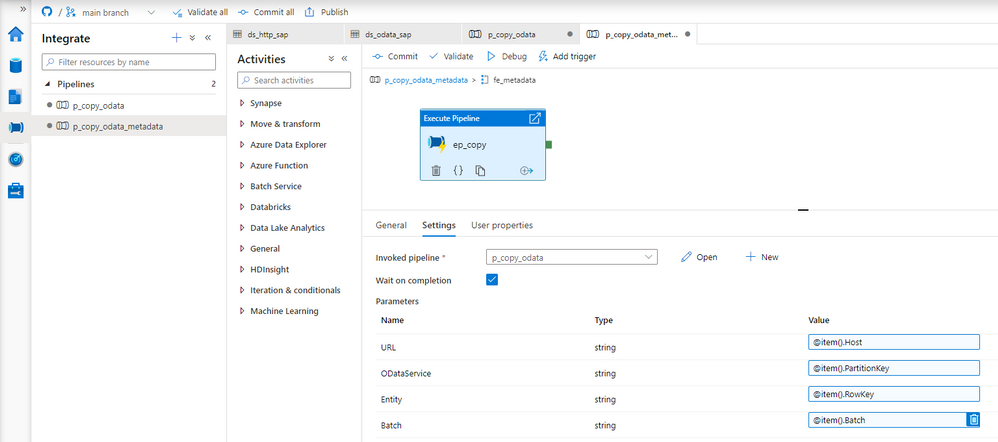
There is a couple of ways to read the record count. Initially, I wanted to use the Lookup activity against the dataset that we already have. But, as the result of a $count is just a number without any data structure, the OData connector fails to interpret the value. Instead, we have to create another Linked Service and a dataset of type HTTP. It should point to the same OData Service as the Copy Data activity.
Create the new Linked Service of type HTTP. It should accept the same parameters as the OData one. Refer to the second episode of the blog series if you’d like to refresh your memory on how to add parameters to linked services.
{
"name": "ls_http_sap",
"properties": {
"parameters": {
"ODataURL": {
"type": "String"
}
},
"annotations": [],
"type": "HttpServer",
"typeProperties": {
"url": "@{linkedService().ODataURL}",
"enableServerCertificateValidation": true,
"authenticationType": "Basic",
"userName": "bjarkowski",
"password": {
"type": "AzureKeyVaultSecret",
"store": {
"referenceName": "ls_keyvault",
"type": "LinkedServiceReference"
},
"secretName": "s4hana"
}
},
"connectVia": {
"referenceName": "SH-IR",
"type": "IntegrationRuntimeReference"
}
}
}
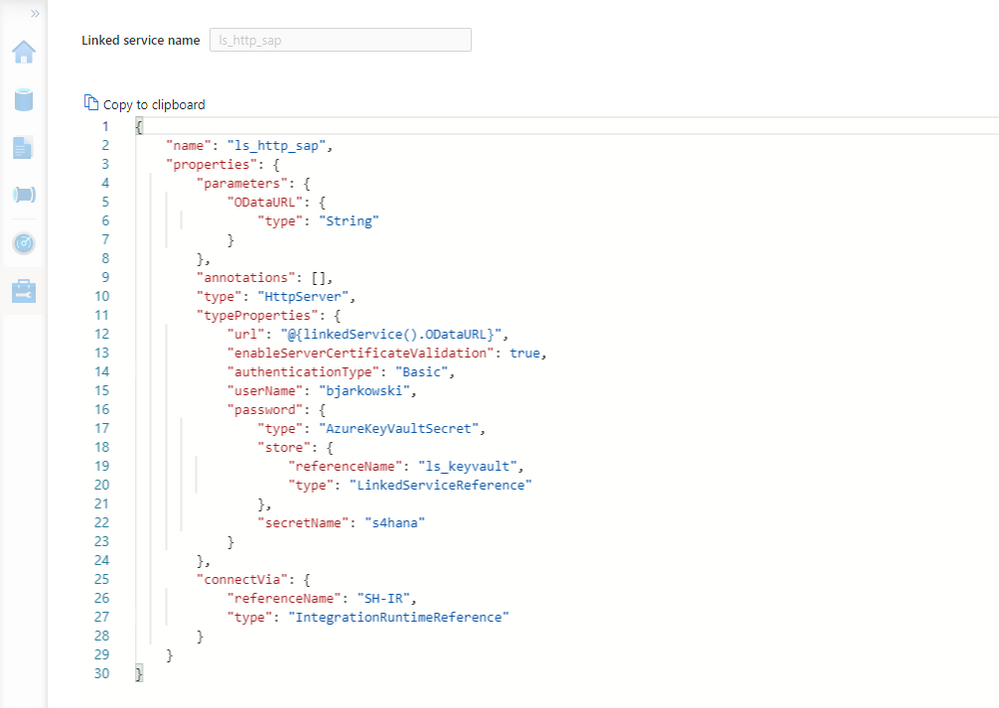
Now, let’s create the dataset. Choose HTTP as the type and DelimitedText as the file format. Add ODataURL and Entity parameters as we did for the OData dataset. On the Settings tab, you’ll find the field Relative URL, which is the equivalent of the Path from the OData-based dataset. To get the number of records, we have to concatenate the entity name with the $count. The expression should look as follows:
@concat(dataset().Entity, '/$count')

Perfect! We can now update the child pipeline that processes each OData service. Add the Lookup activity, but don’t create any connection. Both parameters on the Settings tab should have the same expression as the Copy Data activity. There is one difference. It seems there is a small bug and the URL in the Lookup activity has to end with a slash ‘/’ sign. Otherwise, the last part of the address may be removed, and the request may fail.
ODataURL: @concat(pipeline().parameters.URL, pipeline().parameters.ODataService, '/')
Entity: @pipeline().parameters.Entity

Difficult moment ahead of us! I’ll try to explain all the details the best I can. When the Lookup activity checks the number of records in the OData service, the response contains just a single value. We will use the $skip and $top query parameters to chunk the request into smaller pieces. The tricky part is how to model it in the pipeline. As always, there is no single solution. The easiest approach is to use the Until loop, which could check the number of processed rows at every iteration. But it only allows sequential processing, and I want to show you a more robust way of extracting data.
The ForEach loop offers parallel execution, but it only accepts an array as the input. We have to find a way on how to create one. The @range() expression can build an array of consecutive numbers. It accepts two parameters – the starting position and the length, which in our case will translate to the number of requests. Knowing the number of records and the batch size, we can easily calculate the array length. Assuming the OData service contains 15 elements and the batch size equals 5, we could pass the following parameters to the @range() function:
@range(0,3)
As the outcome we receive:
[0,1,2]
Each value in the array represents the request number. Using it, we can easily calculate the $skip parameter.
But there is one extra challenge. What if the number of records cannot be divided by the batch size without a remainder? As there is no rounding function, the decimal part of the result will be omitted, which means we’re losing the last chunk of data. To avoid that, I implemented a simple workaround – I always add 1 to the number of requests. Of course, you could think about a fancy solution using the modulo function, but I’m a big fan of simplicity. And asking for more data won’t hurt.
Add the ForEach loop as the successor of the Lookup activity. In the Items field, provide the following expression to create an array of requests. I’m using the int() function to cast the string value to the integer that I can then use in the div().
@range(0, add(div(int(activity('l_count').output.firstRow.Prop_0), int(pipeline().parameters.Batch)),1))
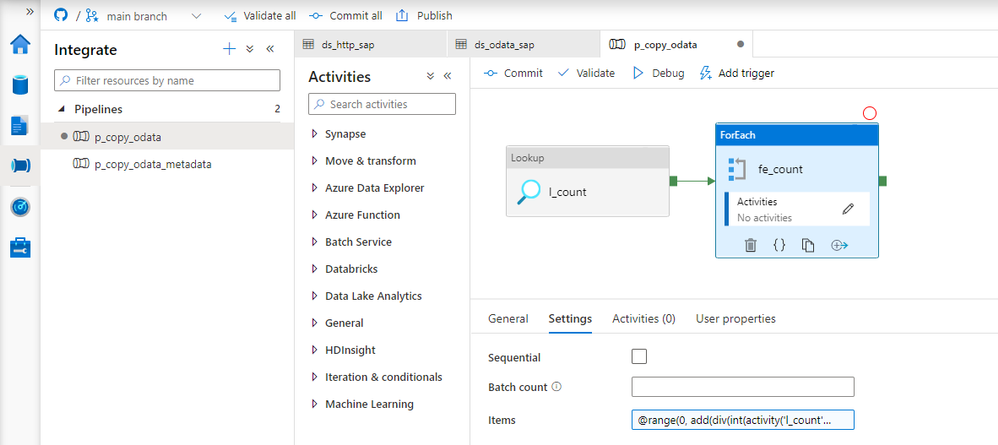
To send multiple requests to the data source, move the Copy Data activity to the ForEach loop. Every iteration will trigger a copy job – but we have to correctly maintain query parameters to receive just one chunk of data. To achieve it, we will use the $top and $skip parameters, as I mentioned earlier in the post.
The $top parameter is static and always equals the batch size. To calculate the $skip parameter, we will use the request number from the array passed to the loop multiplied by the batch size.
Open the Copy Data activity and go to the Settings tab. Change the field Use Query to Query and provide the following expression:
@concat('$top=',pipeline().parameters.Batch, '&$skip=',string(mul(int(item().value), int(pipeline().parameters.Batch))))
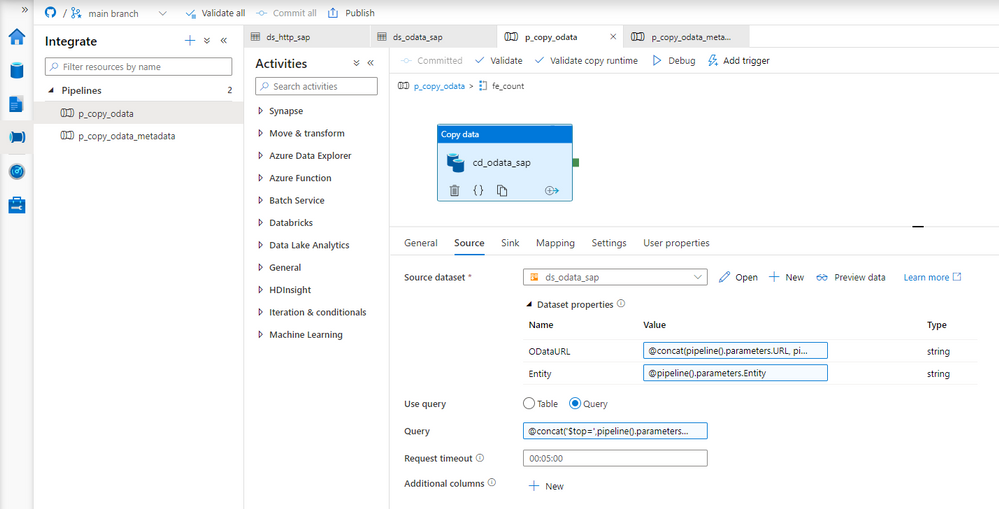
That was the last change to make. Let’s start the pipeline!
EXECUTION AND MONITORING
Once the pipeline processing finishes we can see successfully completed jobs in the monitoring view. Let’s drill down to see the details.
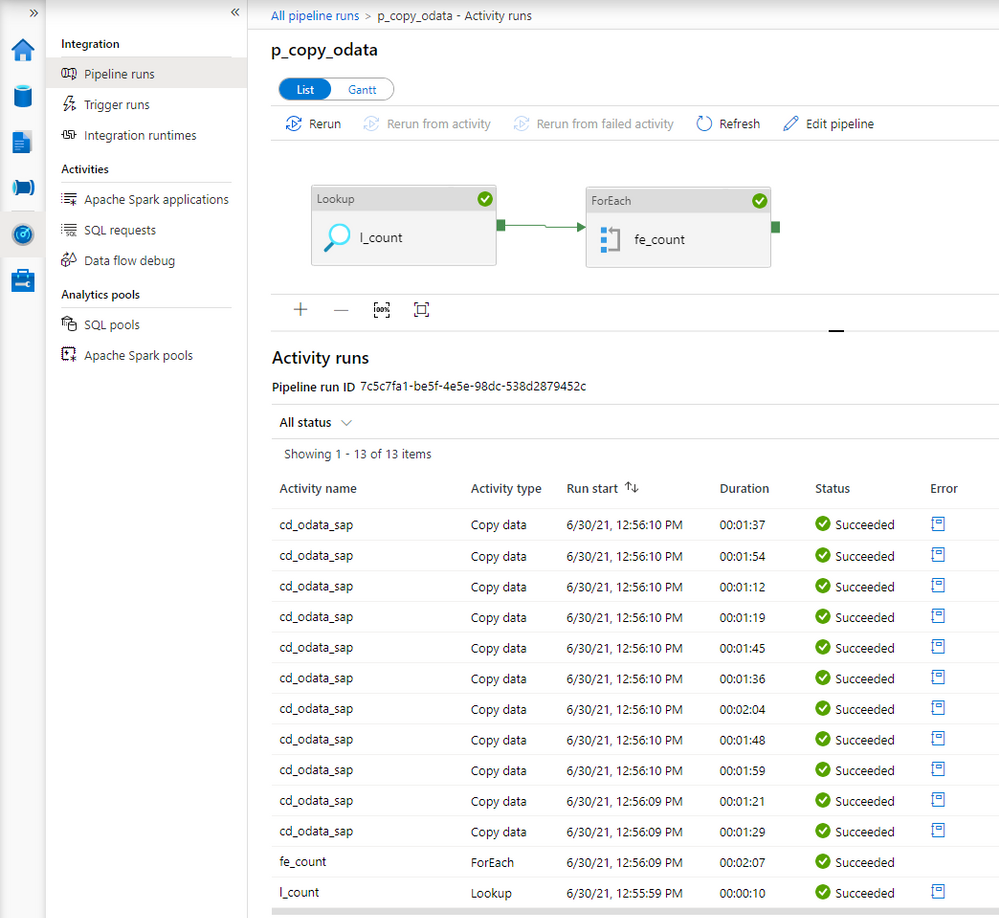
Comparing to the previous extraction, you can see the difference. Instead of just one, there are now multiple entries for the Copy Data activity. You may be slightly disappointed with the duration of each copy job. It takes much longer to extract every chunk of data – in the previous episode, it took only 36 seconds to extract all sales orders. This time every activity took at least a minute.
There is a couple of reasons why it happens. Let’s take a closer a closer look at the components of the extraction job to understand why the duration increased heavily.
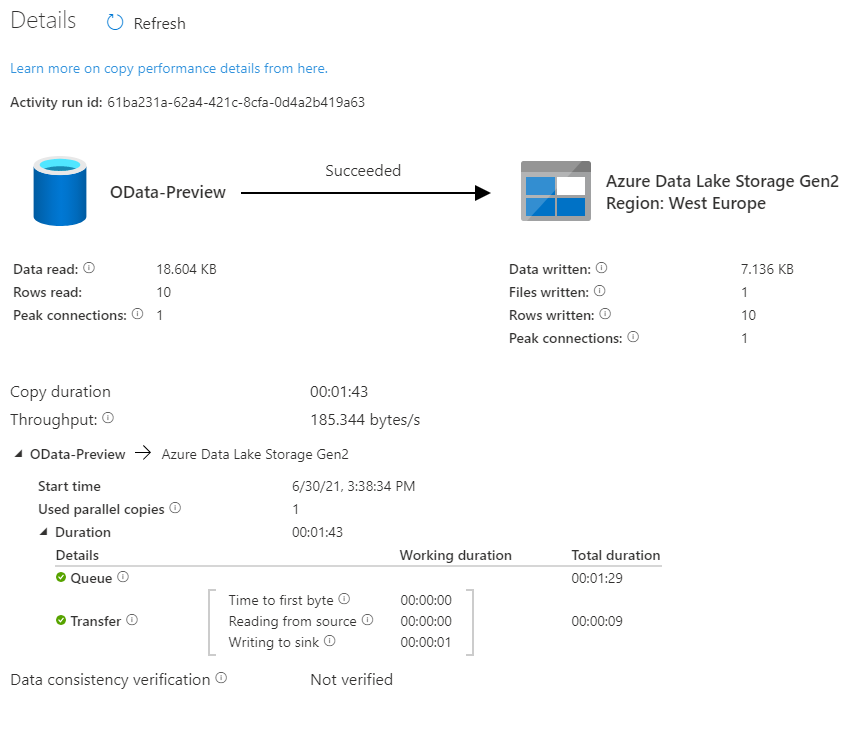
Look at the time analysis. Before the request was processed, it was in the Queue for 1 minute and 29 seconds. Extracting data took only 9 seconds. Why there is such a long wait time?
In the first episode of the blog series, I briefly explained the role of the integration runtime. It provides the computing resources for pipeline execution. To save cost, I host my integration runtime on a very tiny B2ms virtual machine. It provides enough power to process two or three activities at the same time, which means that extracting many chunks is rather sequential than parallel. To fix that, I’ve upgraded my virtual machine to a bigger one. The total duration to extract data decreased significantly as I could process more chunks at the same time.

Here is the duration of each Copy Data activity.
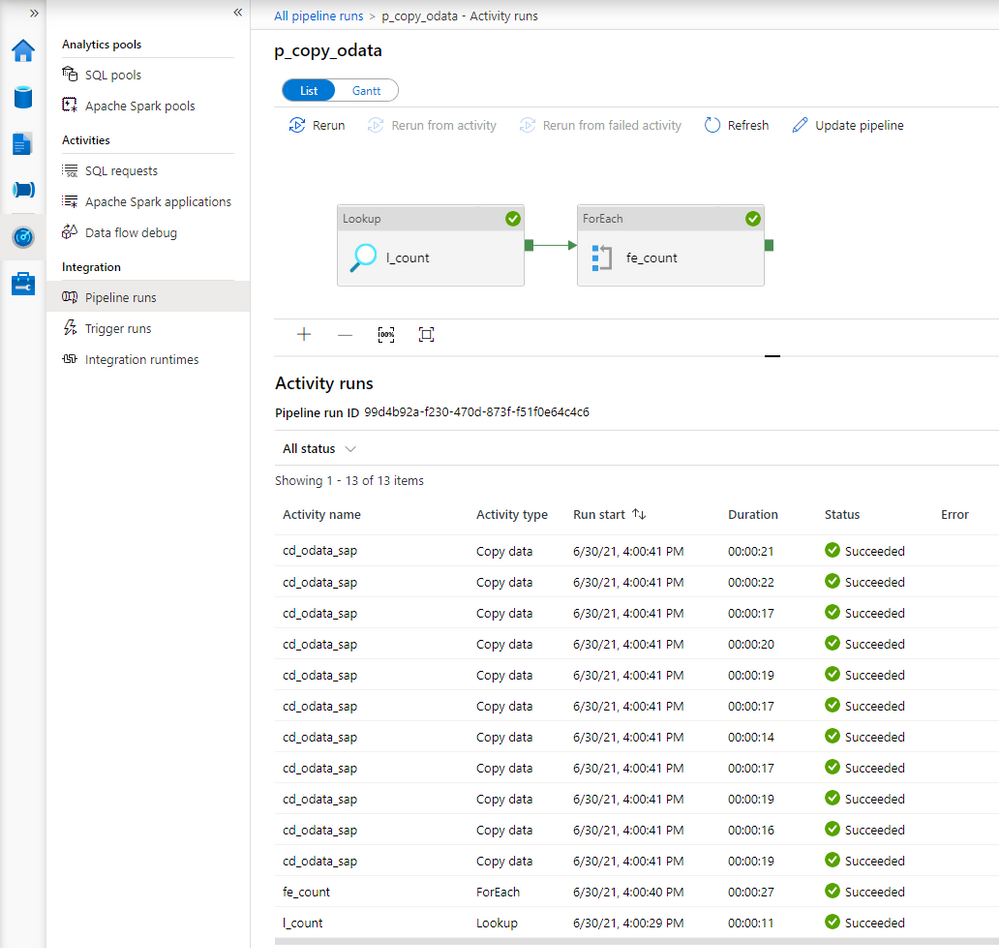
The request is in the queue only for a couple of seconds instead of over a minute.
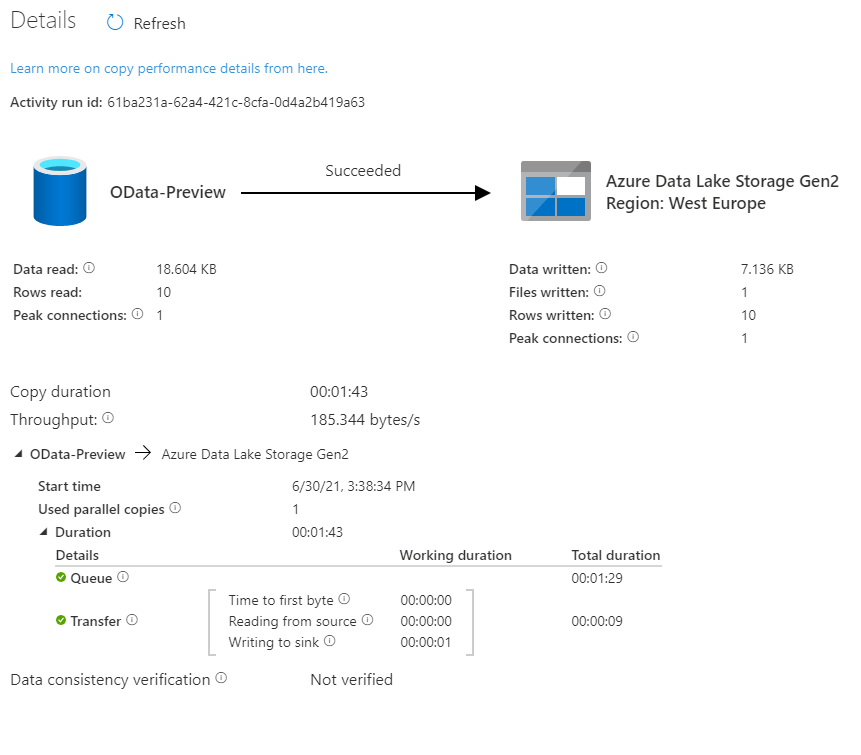
Before we finish, I want to show you some results of processing a large dataset. In another system, I have over 1 million sales orders with more than 5 million line items. It wasn’t possible to extract it all in a single request as every attempt resulted in a short dump at the SAP side. I’ve adjusted the batch size to 100 000 which should be alright to process at a time. To further optimize the extraction, I changed the processing of OData services to Sequential, which means the job firstly extracts Sales Order headers before moving to line items. You can do it in the ForEach Loop in the metadata pipeline. To limit the impact of extraction to the SAP system, I also set a concurrency limit for the Copy Data activity (ForEach loop in the child pipeline).
It took 25 minutes to extract in total over 6 million records. Not bad.

The extraction generated quite a lot of files on the data lake. Let’s count all records inside them and compare the number with what I have in my SAP system:
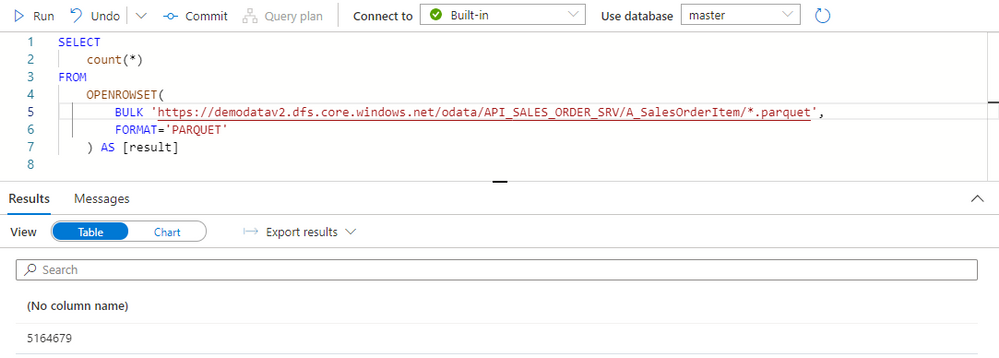
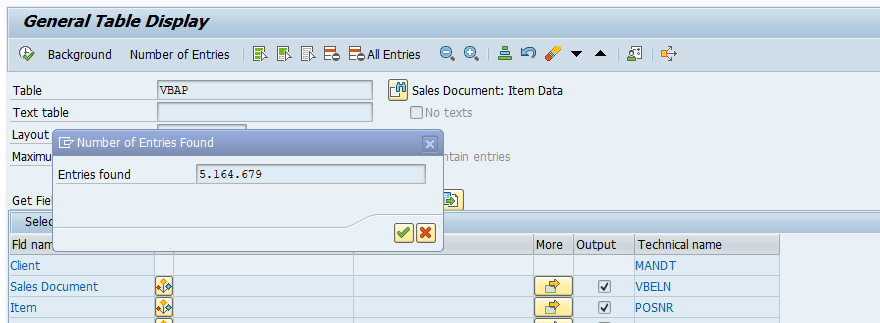
Both numbers match, which means we have the full dataset in the data lake. We could probably further optimize the extraction duration by finding the right number of parallel processes and identifying the best batch size.
Finally, before you even start the extraction, I recommend checking if you need all data. Trimming the dataset by setting filters on columns or extracting only a subset of columns can heavily improve the extraction duration. That’s something we’ll cover in the next episode!

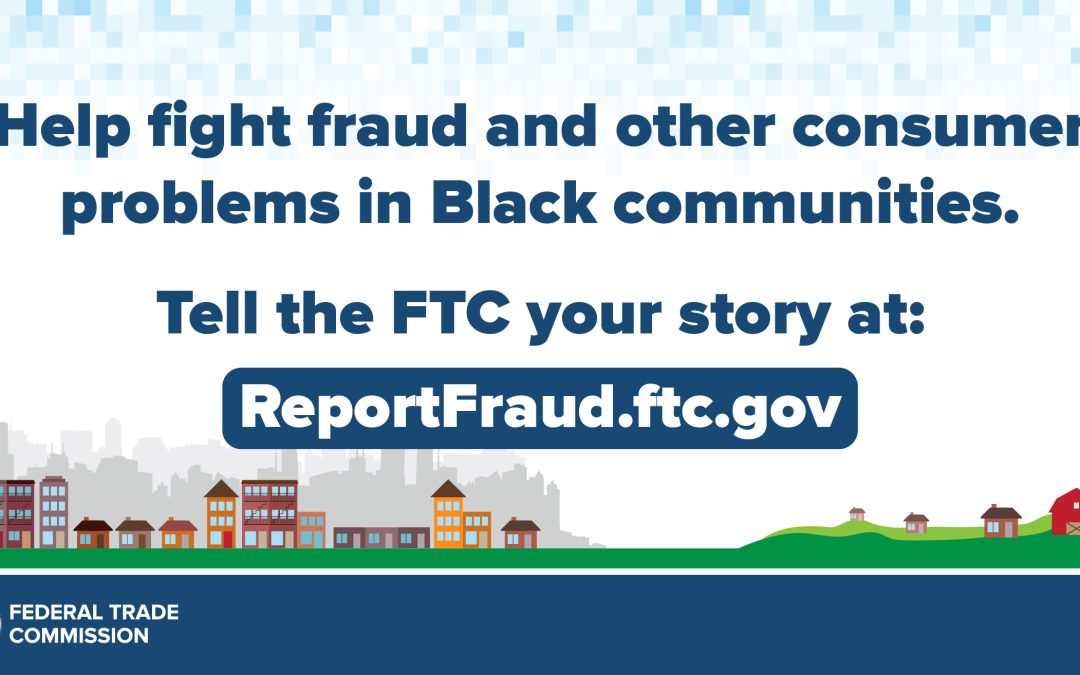
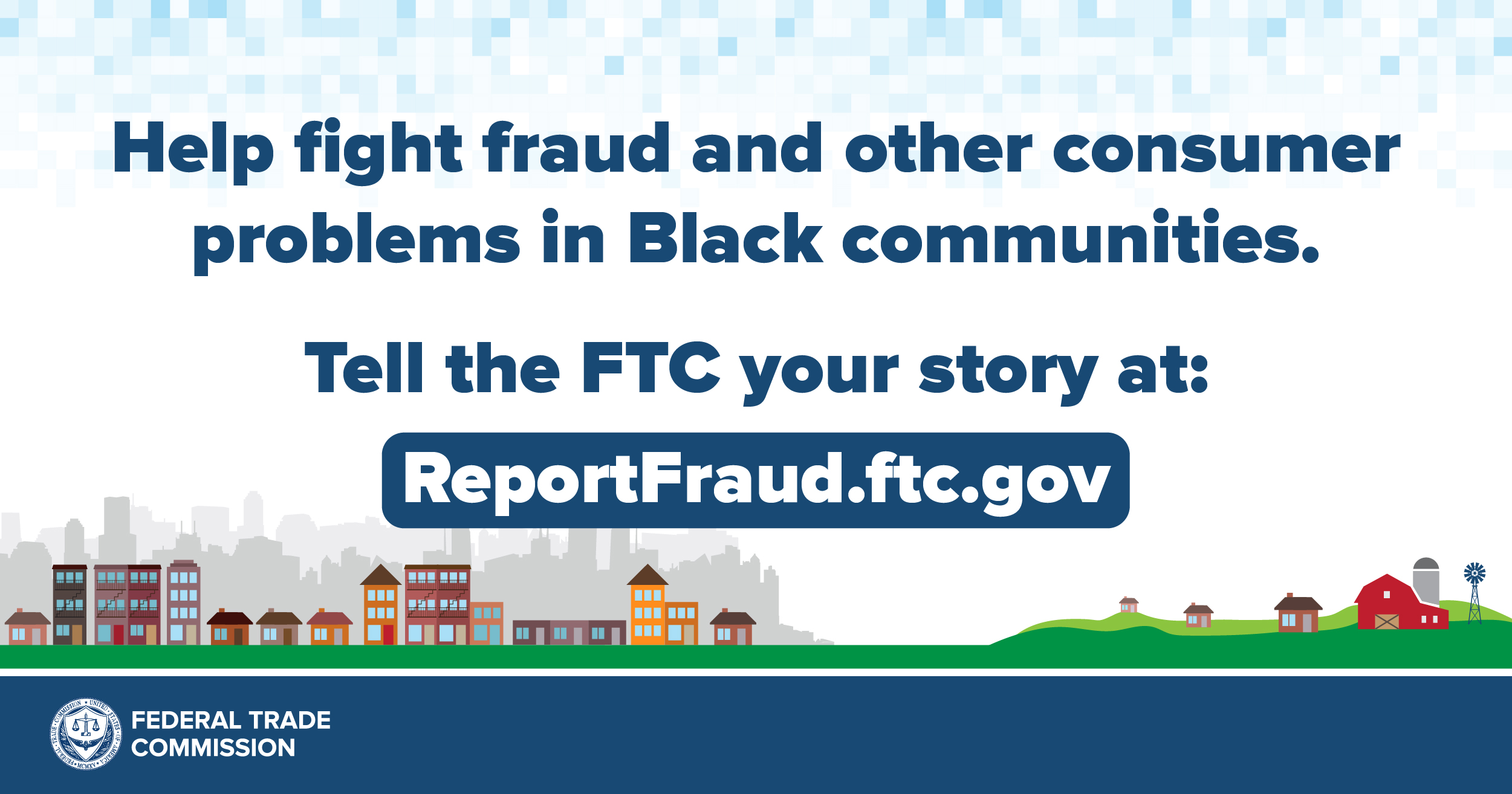





 FTC research confirms
FTC research confirms


















Recent Comments